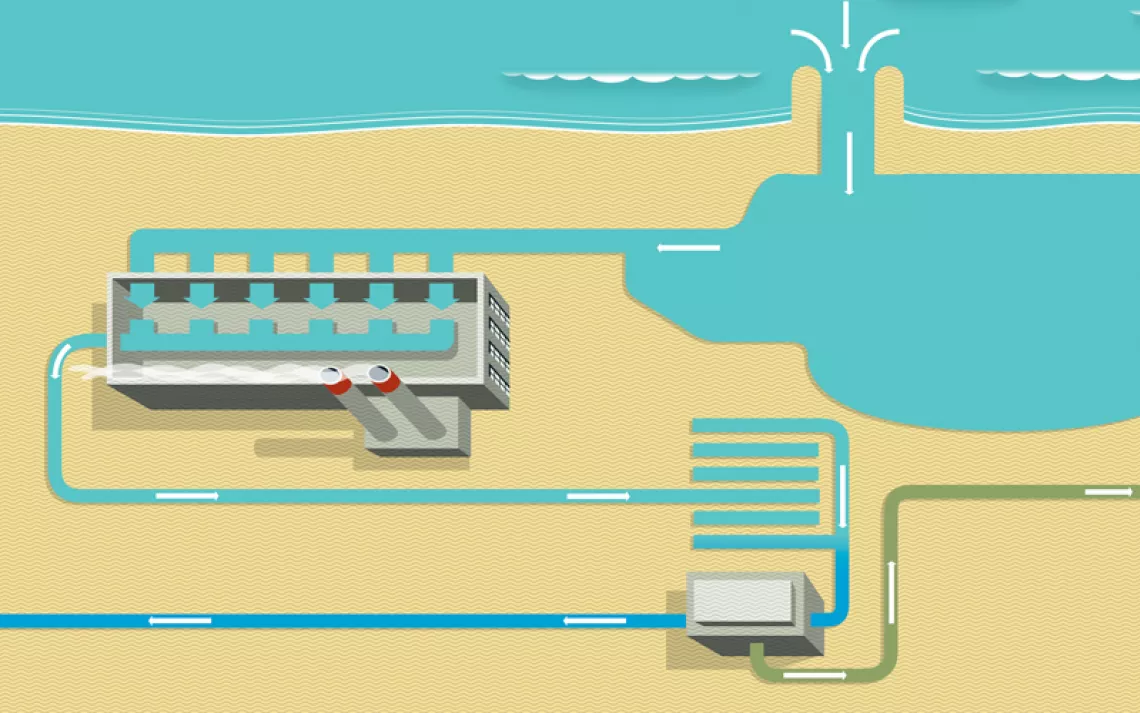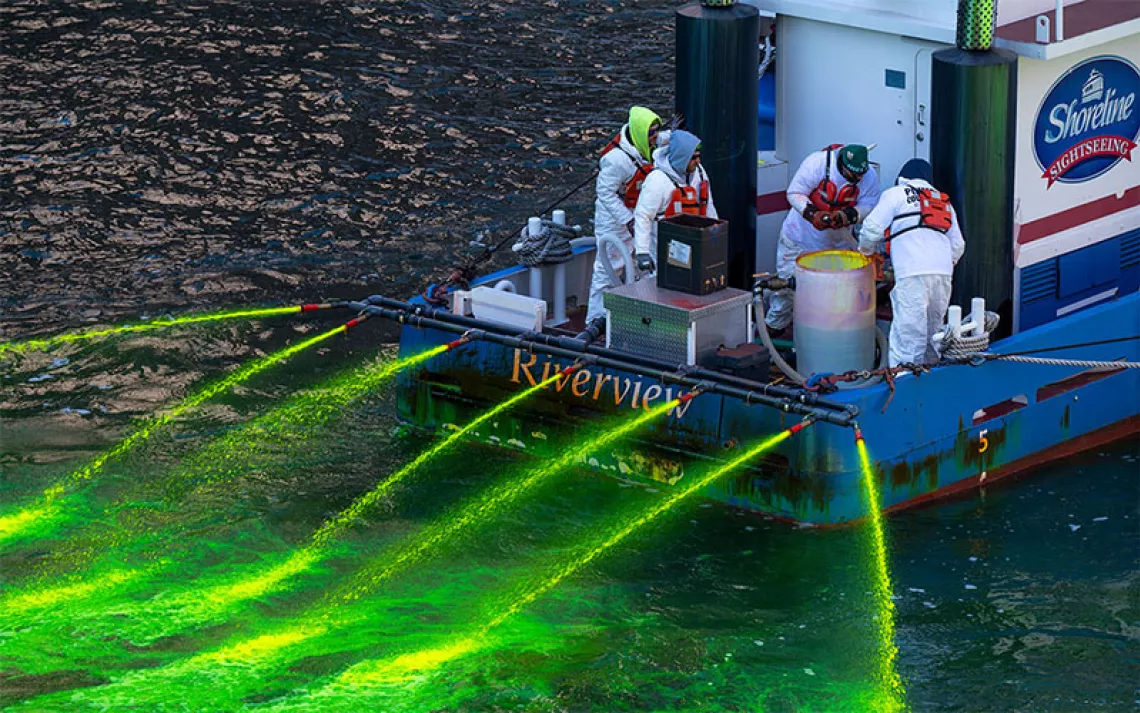Weeks After Dams Fail, Questions Remain About Infrastructure Safety
Michigan private dam owner had been cited for violations but never made repairs

Edenville Dam | Photo by AP Photo/Carlos Osorio
On Sunday, June 7, many residents of Midland, Michigan, joined the nationwide Movement for Black Lives by marching in the streets. More than 1,200 people in the predominately white, suburban community gathered for a racial justice rally in response to the killing of George Floyd by Minneapolis police officers. But there was one key difference between the Midland rally and other events across the country. Many Midland area residents had only recently returned to their damaged or completely ruined homes. Weeks earlier, they had been forced to evacuate after catastrophic flooding occurred when two dams failed on the Tittabawassee River in late May.
“I know many people here are dealing with drying out their basements and fixing damage to their homes,” said Allison Wilcox, a Midland resident and member of the Women of Michigan Action Network who had organized the rally even though she had expected turnout to be low-key. “But this is important, especially for white people right now, to do this work, to support our Black neighbors, and to demand better for the country. We had so many young people who reached out and wanted to help plan this, and it just got bigger and bigger.”
The strong showing for racial justice came as the community continues to recover from the late-May flooding that impacted six Michigan counties. On May 19, heavy rains caused the Edenville Dam, on the border of Midland and Gladwin Counties, to fail, followed by the Sanford Lake Dam in Midland County. At least 10,000 residents in the path of the floodwaters were asked to evacuate as homes and businesses were severely damaged or destroyed.
Although floodwaters have since receded and recovery efforts are underway, the failure of the dams will have significant long-term ramifications and raises disturbing questions. Namely, did the fact that the dams were privately owned, had fallen into disrepair, and been flagged by state and federal officials as unsound make this disaster entirely preventable?
Reporting by Bridge, a nonprofit news organization in Michigan, uncovered federal violations by the dams’ owners, Boyce Hydro Power LLC, dating back as far as 2004 for failing to make repairs to dams. Bridge also reported that, although state and federal agencies reported violations, weak environmental regulations prevented government agencies from being able to force the private owners to make fixes.
Now, homeowners and business owners are filing a wave of lawsuits against the dam owners and the state of Michigan for failing to make the needed repairs. On June 9, the state of Michigan also filed a lawsuit against the dam owners, saying the company ignored regulators for 14 years.
A portion of the area affected by the flooding is represented in Congress by Representative Dan Kildee, a Democrat from Flint Township. For Kildee, assisting his constituents with avoidable infrastructure emergencies has become a tragic theme of his four terms in Congress. Kildee represents Flint, which is still in the midst of recovering from a public health lead-poisoning crisis caused by a state government cost-cutting decision to switch drinking-water sources without implementing proper safety protocols. He also represents Oscoda, Michigan, which is dealing with PFAS contamination that has spread into water sources from a closed US Air Force base.
All three catastrophes highlight the need for something Kildee has long demanded: increased state and federal investments in public infrastructure, before deferred maintenance becomes dangerous or deadly.
“What this shows is that it is far more expensive to do things the wrong way than to do it the right way the first time,” Kildee told Sierra. “Investing in public infrastructure saves us, and not just financially. There is a social cost to losing recreation areas, or doing lasting environmental damage to our communities, or hurting our waterways and natural features.”
Public fear and anxiety about the flooding and dam failures was exacerbated by the fact that Dow Chemical is headquartered in Midland and has a major chemical plant there. Floodwaters mixed with Dow’s containment ponds. In a statement, Dow said that no known chemicals have been released through the ponds into the floodwaters. The company says it is continuing to monitor the situation and has pledged $1 million to aid in the cleanup efforts.
Still, the Michigan Chapter of the Sierra Club raised concerns. Christy McGillivray, political and legislative director of the chapter, told MLive that Dow has “a long and very colorful history of harming public and human health and insisting that they’re not doing anything wrong.”
In the wake of the flood, Representative Kildee also asked for regulatory agencies to ensure that no contamination occurred as a result of the flooding. “It’s not accusatory,” Kildee said. “But it did interact with the containment ponds, so it needs to be looked into.”
The slipshod infrastructure maintenance and the possible threat of chemical contamination are of particular importance in northern Michigan, where rivers, lakes, and public lands are vitally important to local economies that rely on outdoor tourism. Before the flooding, work had just gotten underway to showcase the importance of the Tittabawassee River and surrounding area as a recreation resource. The Tittabawassee Trail Project spans multiple municipalities and is aimed at showcasing the river as a fishery and a destination for kayakers and paddlers.
“Great Lakes Bay Region citizens are extremely fortunate to have fantastic recreational opportunities,” said Brian Lechel, director of the Saginaw County Parks and Recreation Commission. “Tens of thousands of acres of forever protected lands and hundreds of miles of trails provide countless recreational benefits. The Saginaw Bay Watershed is a world-renowned fishery, which likely receives the most out-of-area travel in terms of recreation.”
Lechel had to postpone the group’s first post-flood meeting that was supposed to begin formalizing plans for the project. Immediate goals included creating a map of river access points and amenities and also providing livery-style paddling events so that people who don’t own boats or have much experience paddling could still get a chance to interact with the river. He hopes the group can eventually regroup to see what is still possible for the project this summer.
The infrastructure and environmental questions raised by the flood and the resulting lawsuits will likely take years to solve. But thanks in large part to community support, residents have been able to begin recovering.
“Saginaw and the Great Lakes Bay Region are fortunate to have such great community-minded organizations and neighbors,” Lechel said. “The outpouring of support for those impacted by the flood was immediate and consistent.”
Kildee also noted that, despite the environmental and economic hardships many of his constituents have faced, the ability of residents to continuously help each other is inspirational. "People who have experienced hardship tend to have great capacity for empathy, for taking care of each other,” he said. “I have a lot of pride in what my district represents.”
 The Magazine of The Sierra Club
The Magazine of The Sierra Club



